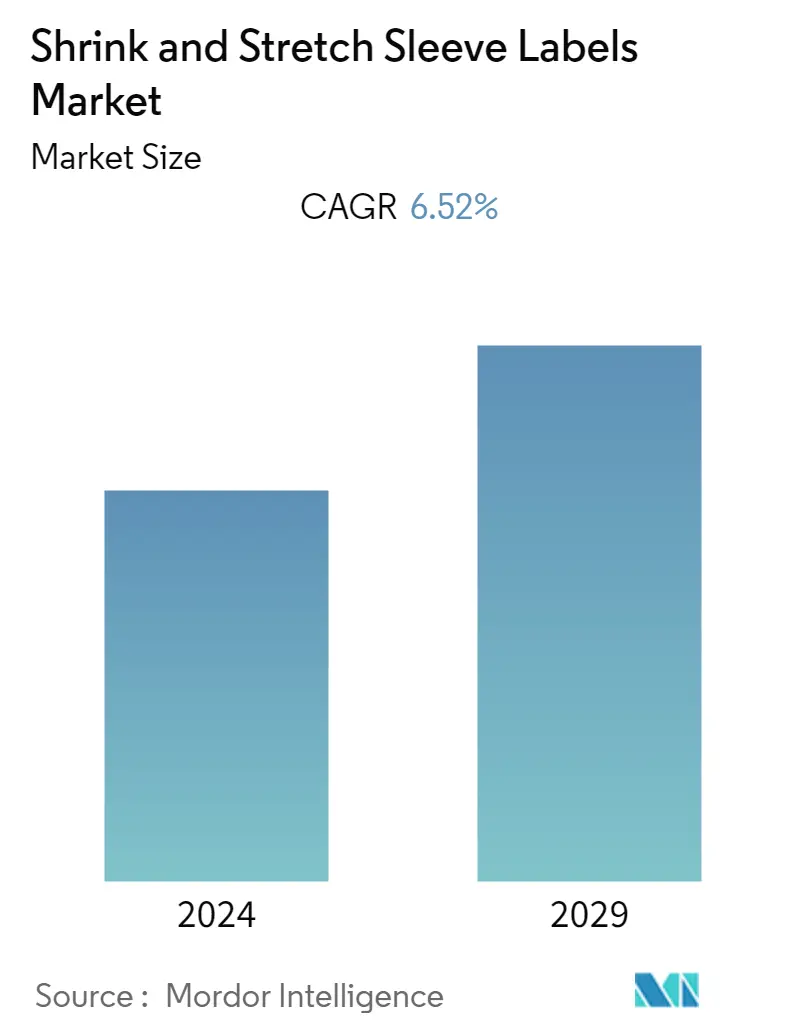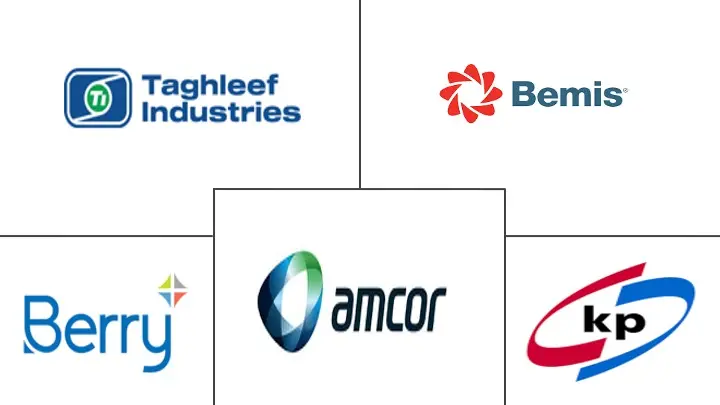Market Size of Shrink and Stretch Sleeve Labels Industry

| Study Period | 2019 - 2029 |
| Base Year For Estimation | 2023 |
| CAGR | 6.52 % |
| Fastest Growing Market | Asia Pacific |
| Largest Market | Asia Pacific |
| Market Concentration | Low |
Major Players
*Disclaimer: Major Players sorted in no particular order |
Shrink & Stretch Sleeve Labels Market Analysis
The shrink and stretch sleeve labels market was valued at USD 10.37 billion in 2020 and is expected to reach USD 15.55 billion by 2026, at a CAGR of 6.52% over the forecast period 2021 - 2026. In the last couple of decades, the labeling and packaging industry has experienced extensive product innovation. Sleeve label is one of those innovative products that has continually gained traction in the packaging landscape. Sleeve labels are colorful wraparounds around containers creating a greater aesthetic appeal.
- These are basically of two types - Shrink Sleeve Labels and Stretch Sleeve Labels. Shrink Sleeve Labels Market are extremely popular in the market and has been readily accepted by the packaging industry. Shrink Sleeve Labels Market easily adapt to the shape of the container giving it higher product visibility and consumer appeal.
- Stretch sleeve labeling is ready-to-use and can easily conform to containers of different shapes. In addition to the characteristics of providing a greater aesthetic appeal, it is eco-friendly. Stretch labels come with zero adhesiveness or heat and rely only on their elasticity to hold the container's shape. As compared to the standard shrink sleeve technology, stretch Sleeve Labels are more cost-effective, and this is expected to positively impact its demand in the future.
- The downside to stretch sleeve labeling is that the application rate is much slower than shrink sleeve labeling, typically less than 150 containers per minute. Shrink sleeve labels are an ideal fit for container package labeling, where the product is generally packed at higher throughput rates of up to 800 containers per minute.
- Manufacturers in the process of prioritizing consumer expectations and constructing better end-user engagement focus on the advanced labeling of their products to maintain a competitive advantage. For instance, recently, Overnight Labels. Inc., a well-known label manufacturing company, introduced a range of craft beer labels comprising of shrink sleeves offering enhanced substrates, varnish, and graphics.
- Due to the outbreak of COVID-19, the supply chain is disrupted in packaging and labeling industry and has impacted the demand and supply of the products. However, governments across the globe have deemed food-related businesses essential, owing to which the demand for shrink and stretch sleeve labels market is expected to be steady during the period.
Shrink & Stretch Sleeve Labels Industry Segmentation
Stretch and shrink sleeve labels are polyester or plastic labels that wrap the entire perimeter of a product and conform to the unique geometry of any package. Stretch labels are made of LDPE and are highly elastic and hence can be pulled over the product container. Shrink sleeves are applied in loose form and conform to the product when exposed to heat by channeling the product through a heat tunnel.
| By Type | |
| Shrink Sleeve | |
| Stretch Sleeve |
| By Material | |
| PVC | |
| PET | |
| PE | |
| OPP & OPS | |
| Other Materials (PO, PLA, etc.) |
| By End-user | |
| Food | |
| Soft Drinks | |
| Alcoholic Drinks | |
| Cosmetics & Household | |
| Pharmaceutical | |
| Others |
| Geography | |||||||
| |||||||
| |||||||
| |||||||
| Latin America | |||||||
| Middle-East & Africa |
Shrink and Stretch Sleeve Labels Market Size Summary
The shrink and stretch sleeve labels market has witnessed significant growth and innovation within the labeling and packaging industry over recent decades. These labels, which wrap around containers to enhance aesthetic appeal, are categorized into two main types: shrink sleeve labels and stretch sleeve labels. Shrink sleeve labels are widely accepted for their ability to conform to container shapes, offering high product visibility and consumer appeal. In contrast, stretch sleeve labels are eco-friendly and rely on elasticity rather than adhesives or heat, making them a cost-effective alternative. Despite their slower application rate, stretch sleeve labels are gaining traction due to their environmental benefits and economic advantages. The demand for these labels is further bolstered by manufacturers' focus on advanced labeling to meet consumer expectations and maintain competitive advantage.
The Asia-Pacific region, particularly China and India, has emerged as a significant market for shrink and stretch sleeve labels, driven by factors such as urbanization, increasing demand for packaged food, and the availability of polymer films. The region's price-sensitive market is expected to see substantial growth due to the cost-effectiveness of these labeling solutions. The COVID-19 pandemic has impacted the market differently across countries, with essential food and beverage sectors continuing to operate. The competitive landscape is highly fragmented, with numerous small and medium-sized players catering to customization needs. Recent developments in the market include advancements in recyclable materials and technologies aimed at meeting sustainability and recycling targets, reflecting the industry's commitment to environmental responsibility.
Shrink and Stretch Sleeve Labels Market Size - Table of Contents
-
1. MARKET DYNAMICS
-
1.1 Market Overview
-
1.2 Market Drivers
-
1.2.1 Ability to Conform to Any Size and Shape, and Yet Provide the Necessary Protection
-
1.2.2 Need for Tamper-evident Protection Will Drive the Shrink Sleeves Market
-
-
1.3 Market Challenges
-
1.3.1 Growing Demand for Stand-up Pouches in the Beverage Sector and Elaborate Nature of the Overall Recycling Process
-
-
1.4 Market Opportunities
-
1.5 Industry Attractiveness - Porter's Five Force Analysis
-
1.5.1 Bargaining Power of Suppliers
-
1.5.2 Bargaining Power of Buyers/Consumers
-
1.5.3 Threat of New Entrants
-
1.5.4 Threat of Substitute Products
-
1.5.5 Intensity of Competitive Rivalry
-
-
1.6 Impact of COVID-19 on the Shrink & Stretch Sleeve Label Market
-
1.7 Analysis of the Key Trends in the Overall Labeling Industry (Share Comparison of Shrink & Sleeve Label)
-
-
2. MARKET SEGMENTATION
-
2.1 By Type
-
2.1.1 Shrink Sleeve
-
2.1.2 Stretch Sleeve
-
-
2.2 By Material
-
2.2.1 PVC
-
2.2.2 PET
-
2.2.3 PE
-
2.2.4 OPP & OPS
-
2.2.5 Other Materials (PO, PLA, etc.)
-
-
2.3 By End-user
-
2.3.1 Food
-
2.3.2 Soft Drinks
-
2.3.3 Alcoholic Drinks
-
2.3.4 Cosmetics & Household
-
2.3.5 Pharmaceutical
-
2.3.6 Others
-
-
2.4 Geography
-
2.4.1 North America
-
2.4.1.1 United States
-
2.4.1.2 Canada
-
-
2.4.2 Europe
-
2.4.2.1 United Kingdom
-
2.4.2.2 Germany
-
2.4.2.3 France
-
2.4.2.4 Eastern Europe
-
2.4.2.5 Rest of Europe
-
-
2.4.3 Asia-Pacific
-
2.4.3.1 China
-
2.4.3.2 India
-
2.4.3.3 Japan
-
2.4.3.4 Rest of Asia-Pacific
-
-
2.4.4 Latin America
-
2.4.5 Middle-East & Africa
-
-
Shrink and Stretch Sleeve Labels Market Size FAQs
What is the current Shrink and Stretch Sleeve Labels Market size?
The Shrink and Stretch Sleeve Labels Market is projected to register a CAGR of 6.52% during the forecast period (2024-2029)
Who are the key players in Shrink and Stretch Sleeve Labels Market?
Berry Plastic Group Inc., Klockner Pentaplast Group, Bemis Company, Taghleef Industries and Amcor are the major companies operating in the Shrink and Stretch Sleeve Labels Market.

